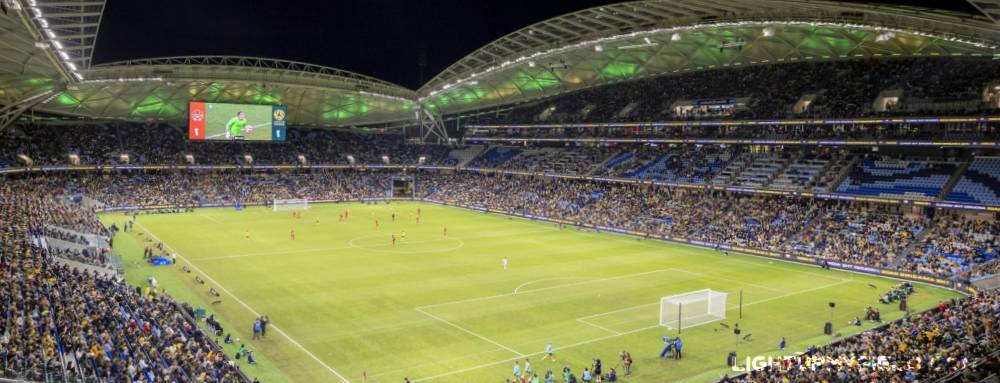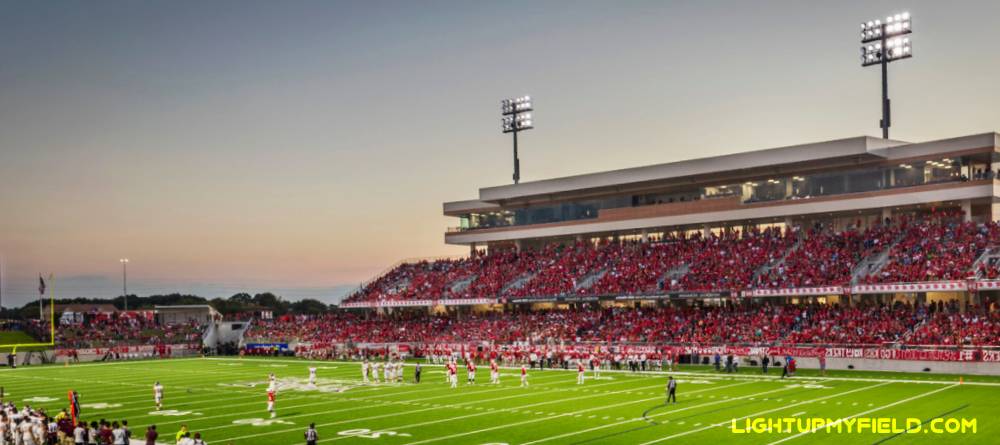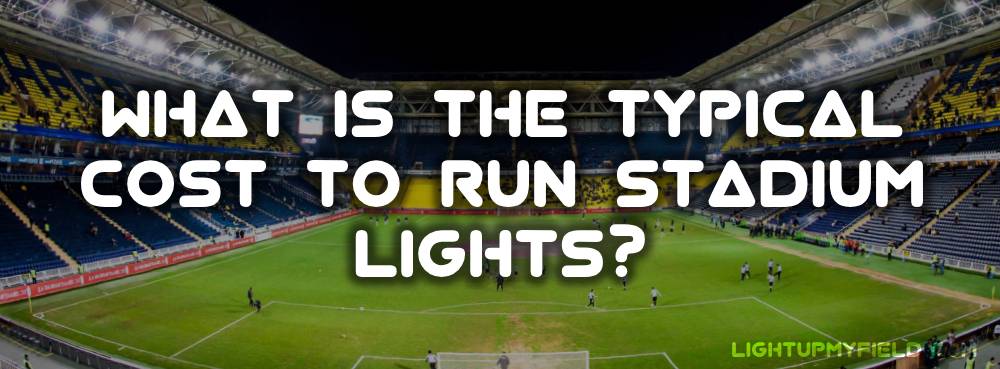Lighting up a stadium isn’t just about flipping a switch. Behind that spectacular glow on game night is a hefty electricity bill that most people don’t really think about. Whether it’s a small local sports field or a massive professional stadium, those lights aren’t cheap to run. So, what does it really cost to keep them on, and what factors play into it? Let’s break it down in a way that makes sense.
Table of Contents
ToggleWhy Do We Need to Understand the Stadium Lighting Running Cost?
Lighting Is One of the Biggest Ongoing Expenses
When it comes to running a stadium, lighting is a major expense. These aren’t your everyday bulbs—they’re massive, high-powered fixtures designed to flood an entire field with even brightness. A single metal halide lamp often draws around 1,500 watts, and a typical sports field can easily have 30 to 50 of them. That adds up quickly: 45,000 to 75,000 watts (45–75 kW) every hour the lights are on.
Now think about how long those lights stay lit. Most games or practices last at least two to three hours, and at an average electricity rate of $0.12 per kWh, one evening event can easily cost $10 to $25 for a small community field. That might not sound like much, but multiply it by 100 events a year, and you’re looking at $1,000 to $3,000 annually—just for lighting.

Costs Scale Up Fast for Larger Venues
If a high school stadium seems manageable, the picture changes for college or professional facilities. Larger stadiums often need 150 to 200 lights, each pulling 1,500 to 2,000 watts. That’s roughly 300,000 watts (300 kW) of power per hour.
Here’s the math:
300 kW × $0.12 = $36 per hour
For a three-hour event, that’s $108 per game. Over 30 events, that’s more than $3,000 per season in lighting alone.
Professional stadiums take it even further. These massive arenas often require 800 kW to 1 MW of lighting. That means $100 to $120 per hour, or $400 for a single game. Over an entire season, lighting costs can easily reach tens of thousands of dollars—and that’s without counting playoffs, concerts, or other events.
Why These Numbers Matter for Decision-Making
Understanding these costs isn’t just trivia; it helps with smarter planning. Without tracking expenses, it’s easy to let energy costs spiral out of control. But when you know the numbers, you can schedule better, decide if an LED upgrade makes sense, and spot inefficient lighting layouts.
Take LEDs, for example. Switching from metal halide to LED can cut energy use by 50% or more. That’s not a small saving—it’s potentially thousands of dollars per year, plus less maintenance and longer bulb lifespan.
It’s About Efficiency, Not Just Bills
Every unnecessary hour of lighting is money wasted. Even cutting one hour per event saves around $15, which adds up to $450 over 30 events. And beyond cost, there’s the environmental benefit of lower energy use, which makes the change even more worthwhile.
Typical Running Cost of Different Kinds of Sports Stadium Lighting
Not all stadiums are built the same, and neither are their lighting systems. The cost to run stadium lights depends heavily on venue size, the type of sport, and the lighting technology in place. To understand how these costs scale, let’s break it down by stadium type.
| Stadium Type | Power Usage | Cost per Hour | Cost per Game/Event | Annual Estimate |
|---|---|---|---|---|
| High School / Community Field | 45–75 kW (30–50 lights × 1,500W) | $5.40 – $9.00 | 2 hrs: $10.80–$18 3 hrs: $16.20–$27 |
~200 hrs/year → $1,000–$2,000 |
| College / Semi-Pro Stadium | 150–300 kW (100–150 lights × 1,500–2,000W) | $18 – $36 | 2.5 hrs: ~$60 per game | ~400 hrs/year → $12,000 |
| Professional Stadium | 800 kW – 1,000 kW (LED or Metal Halide) | $96 – $120 | 4 hrs: ~$480 per game | 10 games → $4,800 Full season/events: $10,000+ |
High School or Community Fields

For a standard high school football or soccer field, the lighting setup usually involves 30 to 50 metal halide floodlights, each consuming about 1,500 watts. That’s 45,000 to 75,000 watts (or 45–75 kW) in total power draw when all lights are on.
Now, if your electricity rate is around $0.12 per kWh, here’s what that means:
- Per hour: 45 kW × $0.12 = $5.40, and 75 kW × $0.12 = $9.00
- For a 2-hour game: $10.80 to $18.00
- For a 3-hour event: $16.20 to $27.00
Doesn’t sound like much, right? But remember, most schools don’t just light up the field for games. There are practices, scrimmages, tournaments, and community events, often several times a week. Let’s assume the lights are used 10 hours per week for 20 weeks (a modest estimate).
- 10 hours × 20 weeks = 200 hours annually
- At 60 kW average, that’s 12,000 kWh per year
- At $0.12 per kWh, the annual cost is about $1,440
So for a small field, you’re easily looking at $1,000 to $2,000 a year in lighting costs alone, and that’s before counting any other power needs.
College or Semi-Pro Stadiums
Now let’s scale up. A college stadium usually hosts larger crowds and more televised events, meaning brighter lighting and more fixtures. It’s not unusual for these venues to have 100 to 150 fixtures, each at 1,500 to 2,000 watts. That puts the total demand at 150 kW to 300 kW.
If we assume a 2.5-hour game, the math looks like this:
- 200 kW × $0.12 = $24 per hour
- For 2.5 hours: $24 × 2.5 = $60 per game
- With 15 home games, that’s about $900 per season for games alone
But here’s the kicker: college fields often stay lit for training sessions, practices, and special events—sometimes 300–500 hours per year.
- At 250 kW for 400 hours, that’s 100,000 kWh annually
- At $0.12 per kWh, that’s $12,000 in lighting costs per year
Suddenly, it’s not just pocket change—it’s a major operating expense.
Professional Stadiums – The Heavyweights
Here’s where the numbers get jaw-dropping. Professional football or soccer stadiums often need 800 to 1,000 lights, even when using energy-efficient LEDs. Why? Because broadcasting standards require extremely high brightness (up to 2,000 lux or more).
A single LED stadium floodlight might consume 1,200 watts, while older metal halides can hit 2,000 watts each. For simplicity, let’s assume a large stadium requires 1 MW (1,000 kW) of lighting power.
So, the cost math for a 4-hour game looks like this:
- 1,000 kW × $0.12 = $120 per hour
- For 4 hours: $120 × 4 = $480 per game
- With 10 home games, that’s $4,800 per season just for lights
Now add concerts, playoffs, night events, and other uses, and you could easily hit $10,000 or more annually on lighting costs alone—even with LEDs. With older metal halides, the number could double.
And remember, lighting is just one piece of the energy puzzle. Add in HVAC systems, giant LED scoreboards, sound systems, and concession areas, and the energy bill for a single event can soar into the thousands.
Calculation Example of Stadium Lighting Running Cost
Sometimes the easiest way to understand the cost is to run the numbers step by step. Let’s take a real-world scenario and do the math.
Example: A Soccer Field with Metal Halide Lamps
Say you have a standard soccer field equipped with 40 metal halide floodlights, each rated at 1,500 watts. These are common in older setups and still widely used.
- Number of lamps: 40
- Wattage per lamp: 1,500 W
- Total wattage: 40 × 1,500 = 60,000 W (or 60 kW)
Your local electricity rate? Let’s go with $0.12 per kWh, which is pretty average in many parts of the U.S.
Breaking Down the Cost Per Game
If the lights stay on for a 3-hour match, the calculation looks like this:
- Cost per hour: 60 kW × $0.12 = $7.20 per hour
- For 3 hours: $7.20 × 3 = $21.60 per event
So, one game under the lights costs you about twenty bucks—not too bad, right? But here’s where it gets interesting.
Annual Cost Adds Up Quickly
A single game might seem cheap, but think about the full year. If that field is used 100 times a year for games, practices, and events, the cost looks like this:
- $21.60 × 100 events = $2,160 per year
Now imagine a sports complex with five fields running on a similar schedule. Suddenly you’re at:
- $2,160 × 5 = $10,800 annually
That’s over ten grand a year just for lighting—and this is based on metal halide lamps, which are pretty inefficient compared to LEDs.
What If You Upgrade to LED?
Here’s the kicker: If you switched that same field to LED lighting, you could cut the wattage nearly in half—from 60 kW down to around 25–30 kW—while keeping the same brightness. Let’s redo the math quickly:
- 30 kW × $0.12 = $3.60 per hour
- For 3 hours: $3.60 × 3 = $10.80 per event
- For 100 events: $1,080 per year
That’s a savings of over $1,000 per field annually, not counting lower maintenance costs because LEDs last up to 6 times longer than metal halides.
How to Reduce Running Cost of Stadium Lighting
So, what can you do to cut down those lighting bills without turning your stadium into a dim cave? The good news is that there are practical steps you can take that don’t compromise lighting quality. Let’s break it down.
Switching to LED Lights – The Biggest Game Changer
If your stadium is still running on metal halide or halogen lamps, you’re basically burning money. LEDs are a game-changer for several reasons:
- They use 50% to 70% less energy
- They last way longer—up to 50,000 hours compared to 6,000–8,000 hours for metal halides
- They start instantly (no more 15-minute warm-up)
Let’s run a quick example. If your current setup uses 60 kW of metal halide lamps, switching to LEDs might bring that down to 25–30 kW for the same brightness.
- Old setup: 60 kW × $0.12 = $7.20 per hour
- New LED setup: 30 kW × $0.12 = $3.60 per hour
That’s a 50% savings right off the bat. If you run the lights 400 hours a year, the math looks like this:
- Metal halide: $7.20 × 400 = $2,880 annually
- LED: $3.60 × 400 = $1,440 annually
Savings: $1,440 every single year—per field. For a large complex or pro stadium, those numbers multiply fast.
Smarter Scheduling and Lighting Control
Here’s something a lot of facilities overlook: lights running when nobody needs them. It happens all the time—after practice ends, lights stay on for another hour because nobody remembered to flip the switch. That’s like paying for a dinner you didn’t eat.
Installing automated timers or smart control systems solves this instantly. You can schedule lights to shut off at a set time or even use motion sensors for auxiliary areas. Some modern systems also offer dimming options, so during a casual practice, you don’t need the same brightness as a championship game.
If dimming can cut even 20% of energy use during practices, and practices account for 50% of your annual lighting hours, that’s another 10% to 15% reduction in your yearly electricity bill without touching a single fixture.
Good Lighting Design from the Start
You’d be surprised how much money is wasted on bad lighting layouts. If the lights aren’t aimed properly, or if you have too many fixtures, you’re basically throwing watts (and dollars) into the sky. A well-designed system does two things:
- Maximizes coverage with fewer fixtures
- Reduces glare and light spill, which not only saves energy but also keeps neighbors happy
Modern lighting design tools can simulate your field before installation, ensuring the perfect balance of brightness and efficiency. Spending a little on a proper lighting plan can save thousands every year in operating costs.
Wrapping It Up
Running stadium lights isn’t cheap, but understanding the real numbers can help make better choices. Whether it’s a small community field or a massive pro venue, lighting costs depend on wattage, duration, and energy rates. With smarter planning and modern tech like LEDs, you can cut costs without cutting corners on visibility.
Next time you see those bright lights shining down on a game, you’ll know there’s more than just energy behind them—there’s strategy, budgeting, and a push to make things more efficient.

